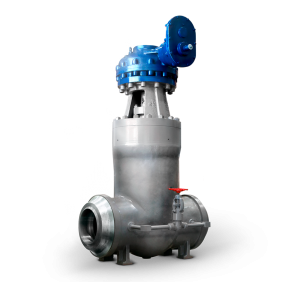|
Ingredients : |
|
|
|
Connection : |
Flanged, Welded, Disc | |
|
Tipler : |
||
|
Temperature : |
max. (+550 °C) | |
|
Nominal Diameter : |
1/2″ – 48″ | |
|
Rated Pressure: |
Class 150 – 2500 |
Valves used in industrial plants are mechanical devices designed to control, direct and stop fluids (liquid, gas or steam). Among these valves, gate valves stand out with their widespread use and robust structure. Gate valves are a type of valve designed to be used in pipelines in fully open or fully closed position to interrupt the passage of the fluid.
What is Gate Valve?
Gate valve is a type of linear motion valve used to control the passage of fluid in a pipeline. It takes its name from the slide mechanism that moves up and down like a gate. When this slide is raised up in the valve body, it allows the passage of fluid, and when it is lowered down, it stops the flow completely.
Gate valves are usually used in the fully open or fully closed position. They are not designed for partial flow control, because in this case the gate and valve surfaces can wear.
Gate Valve Types
Gate valves are divided into various types according to their design and intended use. The most common types are:
- Solid Wedge Gate Valve (Solid Wedge Gate Valve):
- It is the most widely used type of gate valve.
- It has a simple and robust design.
- Suitable for high pressure and temperature applications.
- Flexible Wedge Gate Valve (Flexible Wedge Gate Valve):
- The slide has a flexible structure.
- Resistant to thermal expansion and contraction.
- It adapts to distortions in pipelines.
- Double Disc Gate Valve:
- It works by two disks leaning against each other.
- High sealing performance.
- It is preferred in low pressure applications.
- Parallel Slide Gate Valve:
- It uses parallel disks.
- Widely used in high pressure steam lines.
- Ball Gate Valve:
- It has a more modern design than traditional gate valves.
- It can open and close faster.
How Does Gate Valve Work?
Gate valves consist of a gate and a stem mechanism that controls the gate. The principle of operation is as follows:
- Opening Process:
- When the valve shaft is turned, the slide moves upwards.
- The slide rises to allow the passage of the fluid.
- When the valve is fully open, the fluid passes freely.
- Closing Process:
- When the valve shaft is turned in the opposite direction, the slide moves downwards.
- The bolt closes the pipeline, preventing the passage of the fluid.
- When the valve is fully closed, the fluid passage stops completely.
Gate Valve Usage Areas
Gate valves are widely used in industrial plants and pipelines. The main areas of use are as follows:
- Oil and Gas Industry:
- Control of crude oil and natural gas in pipelines.
- Power Plants:
- High pressure fluid control in steam lines.
- Water and Waste Water Treatment Plants:
- Diversion of water and wastewater.
- Chemical Industry:
- Safe control of corrosive chemicals.
- Food and Pharmaceutical Industry:
- Applications requiring hygienic fluid control.
Gate Valve Advantages
- High Sealing:
- Seals in fully closed position.
- Low Pressure Loss:
- In the fully open position, it offers minimum resistance to the passage of fluid.
- Resilience
- It adapts to high pressure and temperature conditions.
- Wide Application Area:
- It can be used in different industries.
Gate Valve Disadvantages
- Not Suitable for Partial Flow Control:
- There is a high risk of wear and damage when used in the partially open position.
- Slow on and off:
- It works slower than other valve types.
- Maintenance Requirement:
- With frequent use, sliders and surfaces may require maintenance.
Considerations in Gate Valve Selection
- Fluid Type:
- The valve material must be suitable for the chemical properties of the fluid.
- Pressure and Temperature:
- The valve must withstand the operating pressure and temperature.
- Borut Diameter:
- The valve must match the diameter of the pipeline.
- Sealing Requirement:
- Suitable gasket material should be selected for applications requiring high sealing.
Differences Between Gate Valve and Other Valve Types
- Gate Valve vs. Ball Valve (Ball Valve):
- Ball valves can open and close quickly and are suitable for partial flow control.
- Gate valves are used in fully open or fully closed position.
- Gate Valve vs. Butterfly Valve:
- Butterfly valves have a more compact design and are used in low pressure applications.
- Gate valves are more durable in high pressure and temperature applications.
Gate valves are an indispensable part of fluid control in industrial plants. They are preferred in many sectors with their robust structure, high sealing performance and wide range of applications. However, proper valve selection and regular maintenance are critical for a long-lasting and efficient use. Gate valves are one of the most reliable solutions, especially in applications that need to be used in fully open or fully closed position.

